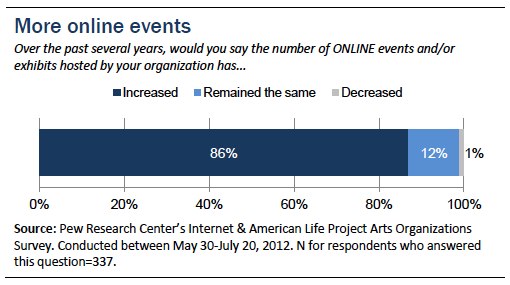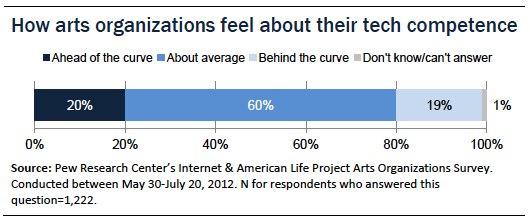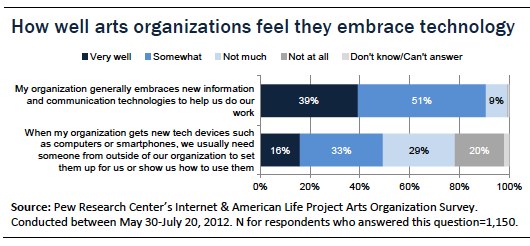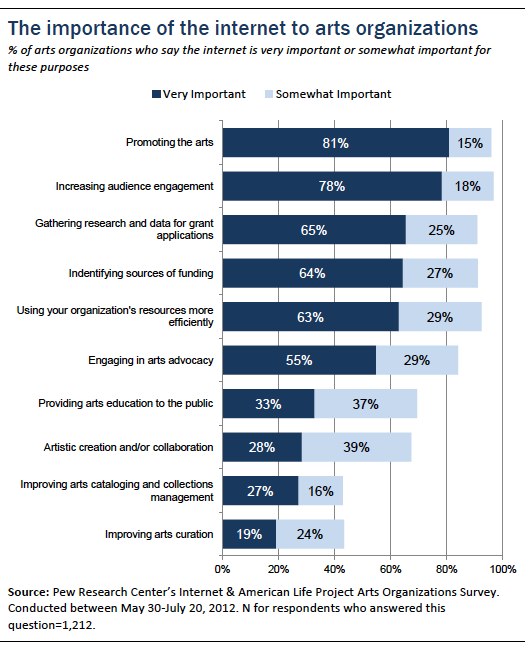The digital technology revolutions that have swept over the American population have affected arts organizations as well. Alongside advances in computing, broadband connectivity, and mobile phones has been the development of social media networks like Facebook, Twitter, and Pinterest, photo-sharing services like Flickr and Instagram, video sites like YouTube and Vimeo, check-in apps like Foursquare, and socially driven recommendation sites like Yelp and LinkedIn. The combination of portable computing, more accessible broadband and wireless, and applications that make it easier to promote, communicate, and share creates a potent mix, not only for the public but also for the arts field.
Arts organizations now have dozens of internet tools at their disposal; tools that can be used to create awareness of their organization, promote events and exhibits, provide customized experiences for patrons, sell tickets or merchandise, streamline customer service needs, and expand access to the arts. Yet even when internet tools are free, there are costs; those associated with staff capacity and training, investments in technological infrastructure, and the insistent need to serve as broad a patron base as possible. Today’s arts organizations are tackling the question of how best to use these tools to serve their mission.
Events
Presenting and hosting events is a core function of many arts organizations. Indeed, 94% of survey respondents say that they host or sponsor in-person events or exhibits. And 29% of the organizations say they host online events, such as webinars, virtual performances, or virtual exhibits.
When asked about changes in the number of events they are curating or hosting, more than half (51%) of the organizations say they are hosting more in-person events than in the past, while 36% say it had stayed the same.
When asked about online or virtual events, 86% of the 337 respondents say the number of events had increased, and another 12% say the number had stayed the same. A scant 1% noted a decrease in the number of online or virtual events.

Online presence and aptitude
Of the organizations completing this survey, 99% state that they have a website, while 97% say their organization has profiles on social media sites such as Facebook, Twitter, YouTube, and Flickr. In addition, 69% of organizations say that individual employees have professional profiles on these social media sites that they use in their capacity as representatives of their organizations.
The survey asked arts organizations to compare against others in their field their ability to use the internet and social media tools effectively. The results draw a typical bell curve; 60% of the organizations say they are “about average” in their internet and social media abilities, while 20% of the organizations say they are “ahead of the curve” and 19% describe themselves as “behind the curve.”

Organizations were also asked about their overall reaction to new technologies. Thirty-nine percent of the organizations surveyed think they generally embrace new information and communications technologies well, while another 51% thought this is only somewhat true of their organization.
There is a larger divergence around staff expertise. About 20% of these organizations disagree with the statement that they need outside assistance to help them set up or run new devices, suggesting that they have the capacity in-house to adopt new technologies. But on the other end of the scale, 16% say that they do rely on outside help to get them up and running with new devices or technologies. The remainder of the responses lie somewhere in between these two points.

The perceived value of internet and digital technologies
Many of the leaders of arts organizations responding to this survey report that the internet and digital technologies are very important to various aspects of their work. Among those who answered this question, a majority consider the internet and digital technologies “very important” for “promoting the arts” (81%), “increasing audience engagement” (78%), and funding-related work (65%). A majority also agree that the internet and digital technologies have had an impact on increasing organizational efficiency, and engaging in arts advocacy.

It is interesting to note where arts organizations are less in agreement about the internet’s impact on collections material. Only 27% of respondents think it’s “very important” for improving arts cataloging and collections management, and 19% feel it’s “very important” for improving arts curation. However, this is more an indication of the differences in arts organizations’ objectives than a dismissal of the internet’s value. There were many organizations (38% and 30%, respectively) that say these activities were simply “not applicable” to their work.
Clearly, the internet is seen as a valuable tool that is “very important” for core organizational work. But the internet and digital technologies are relatively new (and ever-evolving) developments. How are arts organizations adapting to change?
Biggest challenges for adopting new technologies
Survey respondents were also asked an open-ended question about the greatest challenge in adopting digital technologies. The majority of the 1,206 organizations that answered this question cite such things as “cost and staffing issues,” “capacity/funding” or “time and staff resources.” But other organizations more explicitly describe their challenges associated with this transition to more digital marketing, information sharing, and customer service. Some talk about the challenge of just keeping up with change. One notes:
Limited staffing and time. The learning curves for each technology, combined with the number of updates that are required to keep things current, add up quickly.
Others reference the transitional nature of this era. While many new tools help with promotion, marketing and operations, not all patrons are proficient in, care for — or even have access to — online services. With a mission to serve as broad a base as possible, arts organizations are being careful not to exclude non-internet using patrons during this transition. This means many organizations are doing double-duty:
Our biggest challenge in adopting digital technologies is the inconsistent levels of familiarity our audience has with various technologies: some of our patrons do not use — or don’t how to use — a number of digital systems, while other patrons assume and demand such information. We can’t seem to please everybody.
Our established base of constituents and supporters come from an older generation who are not as likely to be comfortable using online and technological solutions. Our challenge is to keep these supporters engaged while trying to reach out to our student participants and younger audience through digital technologies.
Other respondents talk about the difficulty in finding a balance between managing existing work and dedicating time and resources to new initiatives. With limited budgets and staff, how is work prioritized?
Determining how to address the time and resources required to implement/ maintain new digital initiatives while continuing existing activities can be a challenge. Adding new without subtracting something frequently results in attempting to continually do more with static levels of resources/funding.
Some organizations also mention how long — and how much staff tending — it takes for some initiatives to really gain traction:
Deciding how much / finding the time to commit to these technologies has definitely been a big one. As Digital Media Manager, I’m responsible for the website, email and digital marketing … in addition to things like our social media channels, video creation and app maintenance. Finding a balance in all these mediums has proven challenging since social media requires a lot of love + attention over a long period of time to become really effective.
Nearly half of the organizations (49%) report that they have sought funding specifically to support projects that expand their organization’s use of the internet or other technologies, such as apps and social media. This is not surprising, given how many cite costs and funding as one of the major obstacles to adopting new digital technologies.
And, 36% of organizations state that they have conducted research to learn more about how their audiences use technologies.
But, securing funding for technology and trained staff has been “difficult.” Some organizations talk more explicitly about finding the money to support their digital initiatives …
The greatest challenge is obtaining the financial resources needed to hire additional staff and equipment to acquire digital content and manage online efforts.
… and that there are no dedicated revenue streams to fund infrastructure projects.
Staffing – time required to create, manage, and maintain these technologies. Also cost to maintain software, hosting, etc. – small amounts, but cumulative and on-going, without corresponding revenue streams.
Others talk about the challenge of finding money for initiatives that may improve patrons’ experience, but are difficult to connect with audience growth:
It is perhaps most difficult to fund infrastructure and maintenance. Through digital technologies, the capacities of the museum have grown geometrically in collections management, digital assets management, digitally based content and website development, upkeep and outreach. While many of these elements enable access for a large and diverse audience to engage physically and virtually with the museum’s collections and exhibitions, there is little funding available for the technological infrastructure and maintenance that to not directly show metric impact on audiences.
Still others refer to the constant pressure to find funds to maintain and upgrade technology:
Money and resources. Social media is free, but things like mobile technology and integration with online ticketing – even ticketing apps on Facebook for example – aren’t free. Technologies are developing faster than we are raising money to implement them, and we’re facing a significant setback if we can’t keep up.
The expense of maintaining and upgrading technology is considerable and depreciation is inevitable, due to constant advances. We frequently need to determine what investment is most critical and when we can best afford it.
Others challenge the assumption that social media and emerging technologies are low cost or free:
The ability to include them in the already very full plates that our staff and Board carry. If we were in a better financial position we could contract this out, but we can’t afford to. And everyone seems to think that the great thing about internet and digital technologies is that “anyone” can do them. But the fact is, that to do them correctly and to keep doing them, you need to have someone trained and focused on these tasks.
A set of comments address the challenge of integrating these new tools into their workflow to best serve their mission:
[The biggest challenge is] having the time for staff to dedicate to these activities – learning about technology, selecting tools from the many available, thinking about how they can fit into our work, and actually implementing technologies.
Determining what content is most relevant or effective, and what technological channel is most appropriate for that content. Identifying those technologies that visitors feel comfortable using in a museum setting.
One organization sums up the challenges associated with staff capacity and simply keeping up with the velocity of change:
Staff time, plain and simple. We have been very lucky to have supportive, encouraging, and inspired leadership and experimental, smart, and creative staff. We have been careful and judicious in prioritizing which digital technologies should be pursued based on our mission and content. Without resources to add staff, digital projects have been integrated with existing workflows. We’re all doing our best to do more with less. Staying on top of (and sifting through) the rapidly changing field of digital technologies also remains an ongoing challenge.
Thus overall, survey responses clearly show that arts organizations have embraced the internet, (99% host a website and 97% have a social media presence), and that they perceive the internet and digital technologies as “very important” to core parts of their work, including promoting the arts and engaging with audiences. The most common challenges for arts organizations regarding emerging technologies and services relate to the shifting balance among staff capacity, expertise and funding. Many arts organizations envision ways they can better serve their patrons and further their missions using technology and social media, but without funding dedicated to infrastructure and IT initiative, some find themselves struggling to keep up.




